|
Colibrí Crestado Antillano Antillean Crested Hummingbird Orthorhyncus cristatus
|
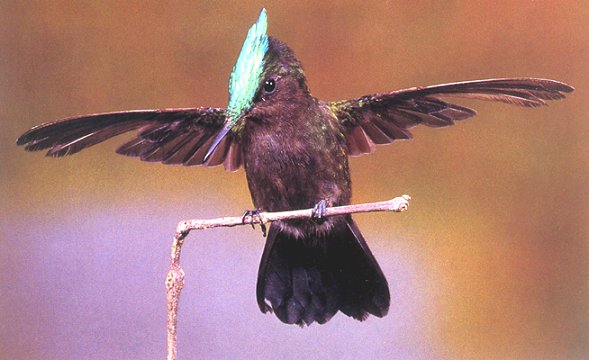 |
|
Foto: R. y E. Tyrrell*
|
|
Colibrí Crestado Antillano Antillean Crested Hummingbird Orthorhyncus cristatus
|
 |
|
Foto: R. y E. Tyrrell*
|
|
IDENTIFICACIÓN: Los machos y las hembras de este pequeño colibrí presentan plumajes muy diferentes. El macho es verde por arriba y oscuro por abajo, con una cresta iridiscente color verde la cual eriza cuando se agita o despliega para la hembra. Por contraste, la hembra no tiene cresta y es color gris claro por abajo. El pico es recto y relativamente corto. Tamaño: 8-10 cm.; peso: 2.0-4.3 g. VOZ: El llamado se ha descrito como una nota doble---"pit-chu". HÁBITAT: El interior de los bosques y jardines. HÁBITOS: Esta especie se alimenta de insectos (hormigas, escarabajos, pequeñas avispas), arañas y néctar. El macho de esta especie, como muchos otros colibríes, ejecuta un cortejo aéreo. En este despliegue nupcial, el macho traza un arco apretado en el aire, volando de extremo a extremo mientras le enseña la brillante cresta verde a la hembra, quien lo observa desde una percha. La nidificación puede ocurrir en cualquier época del año. La hembra construye un nido de hojas, corteza, helechos y telarañas colocado a baja altura en un árbol. Deposita dos huevos blancos y se encarga de toda la incubación, la cual demora cerca de 15 días. Los pichones abandonan el nido a las tres semanas. ESTADO Y CONSERVACIÓN: Este es el colibrí común de pequeño porte en el extremo este de Puerto Rico. DISTRIBUCIÓN: Anida desde el este de Puerto Rico, Culebra y Vieques por el este hasta Granada y Barbados. Esta especie se puede ver con frecuencia al lado de los caminos y en el borde de las arboledas de la Reserva Natural de Humacao. TAXONOMÍA: TROCHILIDAE; Trochilinae. El macho de la subespecie que se encuentra de Puerto Rico a Santa Lucía (Orthorhyncus cristatus exilis), tiene la cresta verde, mientras que los machos de otras subespecies más hacia el sur tienen la cresta azul. Antiguamente llamado Zumbadorcito Crestado. |
|
IDENTIFICATION:. The male and female have very different plumages in this small hummingbird species. The male is green above and dark below, with an iridescent green crest that it erects when agitated or displaying for the female. In contrast, the female lacks the crest, and is a dull, light gray on the undersides. The bill is straight and relatively short. Length: 8-10 cm.; weight: 2.0-4.3 g. VOICE: The call is described as a double note--- "pit-chew." HABITAT: Forest understory and gardens. HABITS: Feeds on insects (ants, beetles, small wasps), spiders, and some nectar. The female builds a nest of leaves, bark, ferns and spider webs, placed low in a tree. The male of this species, like many other hummingbirds, has an aerial courtship display. He flashes his bright green crest in front of the perched female, as he flies back and forth in a tight arc in front of her. Nesting can occur at any time of year. The female builds a nest of leaves, bark and ferns, held together with spider webs, and placed low in a tree. She lays two white eggs and does all the incubation for 15 days. The young fledge at about three weeks of age. STATUS AND CONSERVATION: The common small hummingbird of far eastern Puerto Rico. RANGE: Breeds from eastern Puerto Rico, Culebra, and Vieques, east to Grenada and Barbados. A regular place to find this species is in forest edges and roadsides at the Humacao Nature Reserve. TAXONOMY: TROCHILIDAE; Trochilinae. The male of the subspecies found from Puerto Rico to St. Lucia (Orthorhyncus cristatus exilis) has a green crest, while males of other subspecies farther south have a blue crest. |
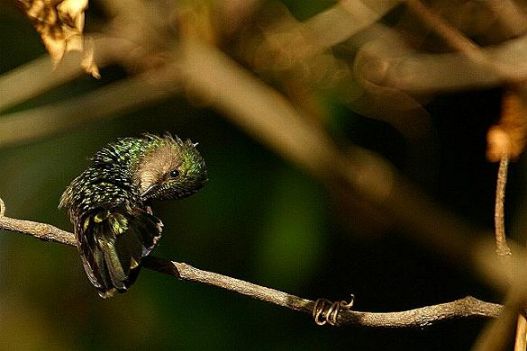 |
|
Hembra - Foto: A. Sánchez Muñoz
|
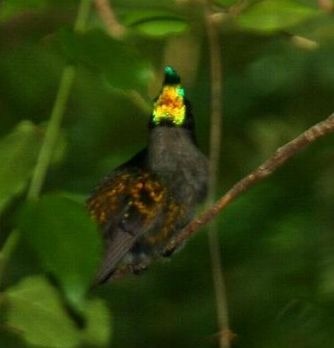 |
|
Foto: A. Sánchez Muñoz
|
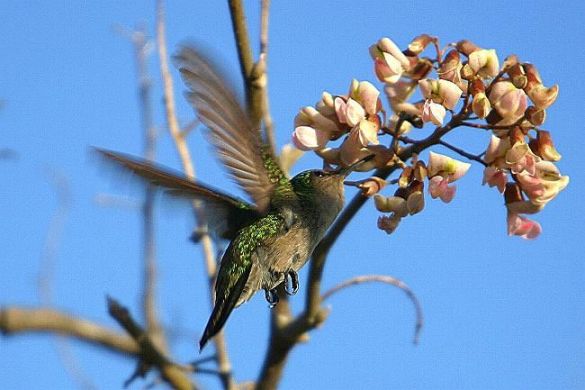 |
|
Hembra - Foto: A. Sánchez Muñoz
|
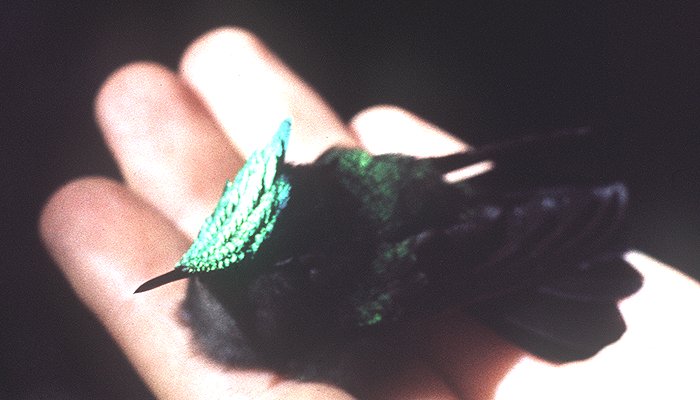 |
|
Foto: J. Faaborg*
|
 |
|
Hembra - Foto: A. Sánchez Muñoz
|
 |
|
|
Hembra - Foto: G. Beaton
|
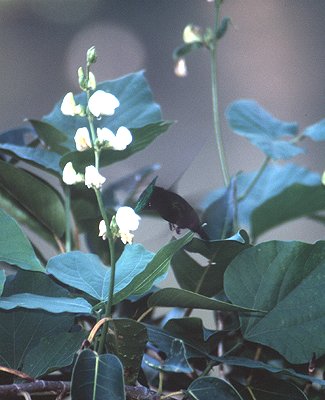 |
|
|
Foto: G. Beaton
|
|
Referencias Chavez-Rámirez, F. and S. S. Tan. 1993. Habitat separation and arthropod resource use in three Lesser Antillean hummingbirds. Condor 95:455-458. del Hoyo, J., A. Elliott, and J. Sargatal, eds. 1999. Handbook of the Birds of the World, Vol. 5. Barn Owls to Hummingbirds. Lynx Edicions, Barcelona. Gerwin, J. A., and R. M. Zink. 1998. Phylogenetic patterns in the Trochilidae. Auk 115: 05-118. Kodric-Brown, A., J.H. Brown, G.S. Byers, and D.F. Gori. 1984. Organization of a tropical island community of hummingbirds and flowers. Ecology 65:1358-1368. Raffaele, H.A. 1989. A guide to the birds of Puerto Rico and the Virgin Islands. Princeton. Raffaele, H.A. 1989. Una guía a las aves de Puerto Rico y las Islas Vírgenes. Publishing Resources, Inc., Santurce, PR. Raffaele, H.A., J.W. Wiley, O.H. Garrido, A.R. Keith, and J.I. Raffaele. 1998. Guide to the birds of the West Indies. Princeton. Schuchman, K.-L. 1979. Notes on the song, territorial behavior, and display of the Antillean Crested Hummingbird, Orthorhyncus cristatus exilis, of St. Lucia, W.I. Bull. Brit. Orn. Club 99(1):30-32. Tyrrell, E. Q. y R. A.Tyrrell. 1990. Hummingbirds of the Caribbean. Crown Publishers, NY. Colibrí Crestado Antillano, versión en inglés Próxima especie en el orden taxonómico Especie anterior en el orden taxonómico |